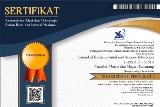The Impact of COVID-19 Pandemic on Gross Regional Domestic Product Growth and Tropospheric Nitrogen Dioxide Pollution in South Sumatra Province, Indonesia
DOI:
https://doi.org/10.15294/jese.v4i1.453Keywords:
air pollution, COVID-19, gross regional domestic product, nitrogen dioxide, OMI, South SumatraAbstract
The objective of the study was to examine the spatial and temporal variation of the tropospheric NO2 column compared with the economic growth during the COVID-19 pandemic. Therefore, the satellite based tropospheric NO2 was acquired from the Aura Satellite during 2019-2021 over the South Sumatra region of Indonesia. The GIS analysis was conducted to produce the quarterly tropospheric NO2 map over the study area. In this study, the gross regional domestic product (GRDP) was used as a benchmark for economic growth. The GRDP would relate to the air pollution to identify possible anthropogenically induced NO2 pollution. The result indicated the GRDP growth significantly decreased when the tropospheric NO2 concentration experienced a great reduction during 2020 (Quarters III-IV). The economic growth reduced from 5.79 to -1.58 during 2019-2020. It was noted that during the decline in GRDP, the variation of tropospheric NO2 was decreased by about 33%.
